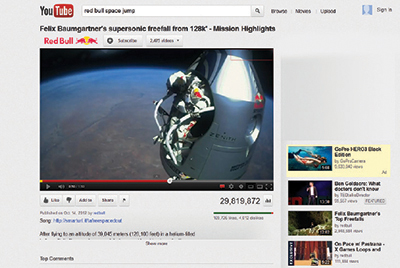Tipping Point for OTT?

Tom Butts
Editor-in-Chief
tbutts@nbmedia.com
In many ways, the development of video technology has paralleled man’s exploration of space over the past five decades, from specialized cameras documenting such history- making events as John Glenn’s spacewalk, to Neil Armstrong’s walk on the moon and most recently, Felix Baumgartner’s astounding 24-mile space jump in October. Developing technology for miniaturized cameras and lenses that can withstand the rigors of space has helped lead to improved capabilities for covering more earthbound activities such as sports and exploration.
Baumgartner’s jump, though, also represented a breakthrough for online video entertainment as the event marked the largest audience for an online televised (to use today’s phraseology) event in history, as 8 million viewers logged into YouTube worldwide, for a total of 52 million concurrent streams. The event was also televised live on the cable news networks as well as the Discovery Channel.
The fact that YouTube garnered such a large audience isn’t all that surprising when you consider how the market for streaming (and “over-the-top”) video has gained more acceptance. Portable devices including tablets and smartphones are the driving forces behind this new media explosion, with OTT boxes including Xbox360, Roku and Apple TV (the real one, not the much hyped one that remains a figment of too many analysts’ imaginations), also becoming increasingly ubiquitous.
A recent poll from Harris Interactive confirmed these facts, noting that of the more than 2,300 adults surveyed two months ago, 52 percent indicated that they had watched digitally streamed TV programming on one of several devices, including the aforementioned smartphone, tablet, PC or streaming box.
Not too surprisingly, the largest proponents of streaming are in the 18–35 age group. “Streaming is well on its way to becoming a dominant means of viewership among 18–35 year olds, (nearly tying topranked live feed TV) as it airs or among the ways they most often watch TV programming (44 percent live feed TV, 41 percent streaming),” Harris said.
The market for streaming video is not without its pitfalls however. Netflix hasn’t exactly set the media world on fire with its recent efforts at original programming; and Google recently cancelled up to 70 percent of YouTubes’ “TV channels,” a year after the $100 million initiative for original programming was launched. And lest we think that traditional TV is on the way out, the vast majority (89 percent) of respondents to the Harris poll indicated that they watch TV programs on the TV sets, sans streaming.
The professional video industry's #1 source for news, trends and product and tech information. Sign up below.

YouTube garnered its largest audience in history when Felix Baumgartner took his famous leap from space. What will prime the pump even more for video streaming? Respondents to the Harris survey indicated that improved streaming options, including access to faster connections, ease of access, (including not having to watch on a PC screen), and access to programming they currently cannot get via streaming are the biggest factors in increasing their streaming views.
That last item confirms that “content is (still) king.” Survey after survey has indicated that more consumers would cut the cable or satellite cord if they had access to live programming, especially sports and news either via the cable news networks or their local TV station.
With national and regional sports rights fees expected to exceed $100 billion over the next dozen years, cable subscribers (including industry pioneer John Malone) are growing increasingly agitated over the effects such fees are having on their cable bill and the pressure to find a solution will only increase over time. Anthony Wood, the CEO of Roku, recently predicted that the company will offer cable or satellite subscriptions via their streaming box within the next 12 months. And Adobe’s recent announcement of its “Project Primetime” platform that could allow the insertion of local advertising into broadcast streams helps remove some of the technical barriers to bringing broadcast to the streaming box.
The pace of acceptance for streaming is accelerating and its expected dominance is not a matter of if, but when.
Tom has covered the broadcast technology market for the past 25 years, including three years handling member communications for the National Association of Broadcasters followed by a year as editor of Video Technology News and DTV Business executive newsletters for Phillips Publishing. In 1999 he launched digitalbroadcasting.com for internet B2B portal Verticalnet. He is also a charter member of the CTA's Academy of Digital TV Pioneers. Since 2001, he has been editor-in-chief of TV Tech (www.tvtech.com), the leading source of news and information on broadcast and related media technology and is a frequent contributor and moderator to the brand’s Tech Leadership events.

